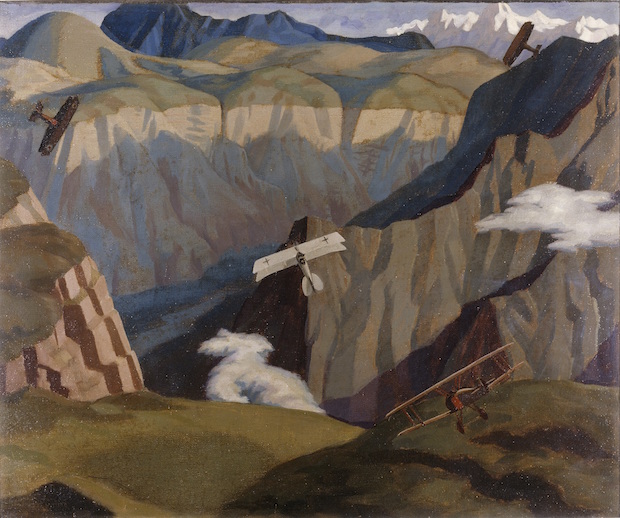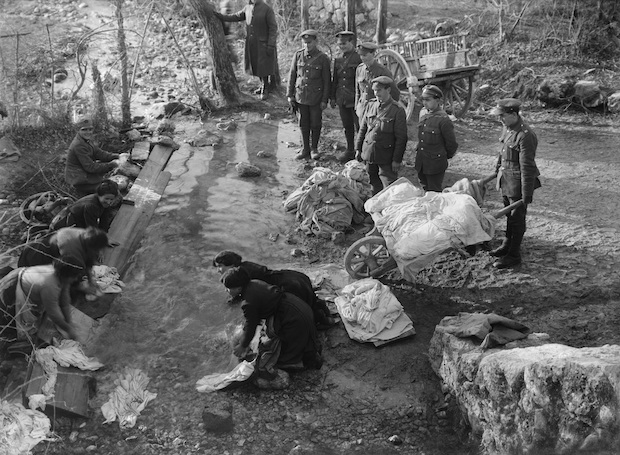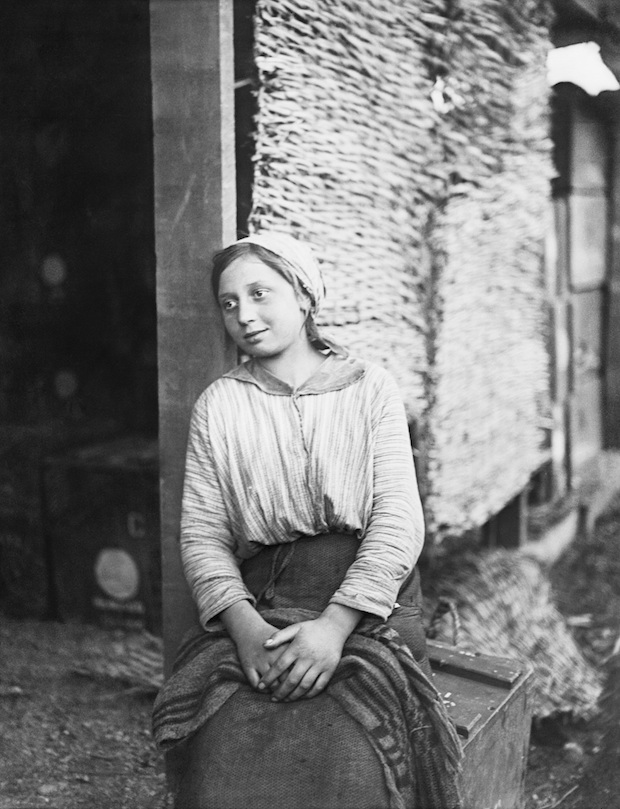If the First World War heralded a new age of mechanised warfare, Sydney Carline’s paintings show just how primitive the new technology was. There’s nothing sleekly metallic about the Sopwith Camels he shows attacking an enemy aerodrome in 1918: instead the surrounding aircraft are as fragile as birds, the landscape unnervingly vibrant and close, emphasising the vulnerability of flesh and blood and bones in these flimsy machines. Full of the exhilaration of flight, his rapid, expansive brushstrokes are as jagged as machine-gun fire, evoking the noise and fury of battle.
Carline (1888–1929) went to northern Italy as part of the expeditionary force sent to assist the Italians after the fall of Caporetto (now Kobarid in Slovenia) in the autumn of 1917. Marking the reopening of the Estorick Collection after a five-month refurbishment, this exhibition, featuring 24 of Carline’s paintings and drawings, and some 50 works by official war photographers William Joseph Brunell (1878–1960) and Ernest Brooks (1878–1941), forms a vivid and often surprisingly intimate account of this little-remembered episode.

The Destruction of an Austrian Machine in the Gorge of the Valley of the Brenta (1918), Sydney Carline. Courtesy: Imperial War Museum
Carline was a gentle soul and a most unlikely fighter pilot, but his love of flying is reflected in his paintings. He had an eye for scenery too, even in the heat of battle; in moments of solitary contemplation he found serenity in the perfect colours of a sunset, or the glacial calm of the mountains seen from above. Appointed as an official war artist in July 1918, Carline flew with a drawing board across his knees, his machine guns loaded just in case. A sheet of watercolour sketches showing four views of Italian mountains drawn mid-flight gives little indication of his struggles with freezing paints, the water forming tiny shards of ice that flew from the page. Eventually he conceded defeat, making an initial pencil or charcoal sketch that he would develop as soon as possible after landing.
Best known today for his pictures of Passchendaele and the Somme, Ernest Brooks was not impressed by the Italians, nor particularly by Italy. As an old soldier, his interest was mainly military, capturing encounters between British and Italian soldiers of all ranks, and taking some more formal pictures of the top brass. Even so, his pictures of civilians are certainly not unsympathetic, and show British soldiers living in close quarters with the stricken Italians, many of whom had had to flee their homes as German and Austro-Hungarian troops advanced.

Men of the Royal Engineers watch as their clothes are washed in a stream by Italian peasant women (November-December 1917), Ernest Brooks. Courtesy: Imperial War Museum
When Brooks left Italy for the Western Front in September 1918, he was replaced by William Brunell, a man with no military experience who had volunteered as a photographer not least because his poor health made him fearful of conscription. His pictures show a touching affinity with the soldiers he photographed; like them he was curious about his unfamiliar, exotic surroundings and perhaps a little in awe of the local women.
Like Carline, Brunell had an eye for the picturesque. His portrait of a young Italian woman is subtly reminiscent of a Raphael Madonna. But for all his aesthetic sensibilities, Brunell was never inclined to sentimentality and his pictures of ruins and ravaged countryside have instead an elegiac quality. Despite having initially welcomed the move south, the British quickly found that the Italian Alps were as punishing a terrain as anything they had previously experienced. Brunell’s photograph of cavalry crossing a stream could just as easily show the flatlands of northern Europe, the marshes around Venice providing more of the muddy conditions the troops had endured on the Western Front. Sometimes Brunell’s photographs have a modernist bent, a pattern or visual oddity catching his eye. His photograph of a woman lying on a vast pile of shells has a sort of dark humour, the repeating cylindrical pattern and expanse of metal somewhat reminiscent of themes that his friend Paul Nash would go on to explore.

A Young Italian Woman Employed by the British Army in Italy (November 1918), William Joseph Brunell. Courtesy: Imperial War Museum
Carline’s exuberant aerial views make an arresting contrast with his charcoal drawing – almost monumental in scale and gravitas – of an injured comrade being led away from his aircraft, while elsewhere the legs of a dead soldier protrude awkwardly from a dugout. These in turn are hard to reconcile with his beautiful pen and ink drawing of a group of Alpini, an elite corps of the Italian army, as they rest in a mountain landscape. One feels that he couldn’t resist a romantic treatment, the timeless setting and oddly antiquated feather caps combining with dense hatching and an emphatically linear style to evoke an Old Master drawing.
A fitting tribute to the friendship between Britain and Italy, this exhibition explores a truth more nuanced and perhaps even more difficult to countenance than the devastating effects of war. Carline’s experience of the ‘sun and light and delight’ of Italy was not unalloyed; his paintings and the photographs of William Brunell in particular are testament to the conflicting emotions and impulses of those whose lives were enriched as much as blighted by war.
‘War in the Sunshine: The British in Italy 1917−1918’ is at the Estorick Collection of Modern Italian Art, London, until 19 March.
From the March 2017 issue of Apollo. Preview and subscribe here.
Unlimited access from just $16 every 3 months
Subscribe to get unlimited and exclusive access to the top art stories, interviews and exhibition reviews.














![Masterpiece [Re]discovery 2022. Photo: Ben Fisher Photography, courtesy of Masterpiece London](http://zephr.apollo-magazine.com/wp-content/uploads/2022/07/MPL2022_4263.jpg)
The threat to Sudan’s cultural heritage